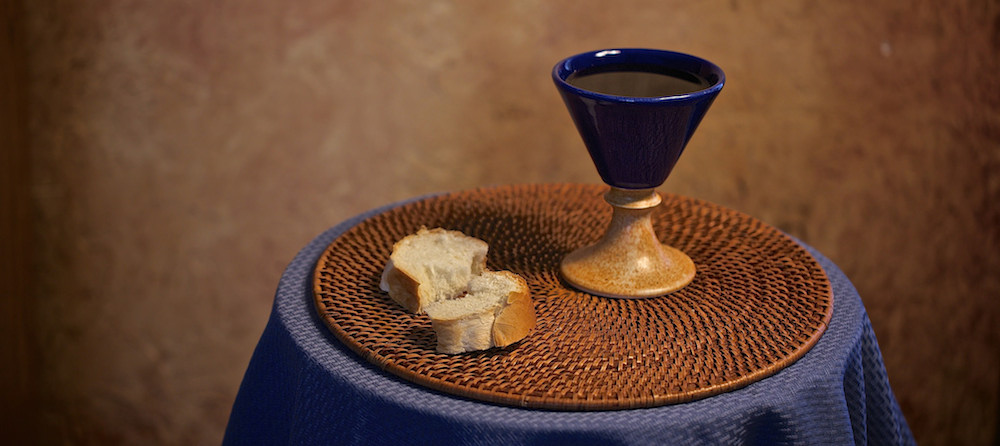Languages and words, although equivocal, are powerful conveyors of truth and meaning. One such word that comes to mind is symbol. The Greek word, symballein, means to bring or throw together. I understand this to mean that symbols are more than mere signifiers or reminders since they actually participate and make present that which they symbolize. In a religious sense, symbols bring together the divine and the mundane. The Eucharist is the preeminent symbol of Christian faith. As a meal and sacrifice, it brings together Christ and the Church in ritual celebration. In partaking of it, we relate to the one transcendent God through Jesus Christ. Theologically, this has profound significance. Moreover, the Eucharist is profoundly symbolic because it brings us together as one people sharing in the one meal. The Second Vatican Council understands it as the “sacrament of unity”, whose symbolic sense points to the gathered assembly in communion with one another and with the entire human family (Sacrosanctum Concilium 26).

Communion is a word that I find redundant and excessive since it connotes the idea of a common union. Last month, during our son’s First Communion, my family experienced how profusive this word is. As a family, we had the chance to plan all aspects of the celebration. My wife is a co-catechist in our son’s religious education classroom, and my brother is a Catholic priest. Therefore, we made the decision that we wanted our son to celebrate this sacrament with his family in a ceremony presided by his uncle instead of with our parish community. A driving factor for our decision was based on the idea advanced by the General Directory for Catechesis, which states that we should not consider children to be only the objects of catechesis since they are subjects and protagonists in evangelization and more importantly, agents for social renewal (183). In my opinion, being able to grasp the meaning of the Eucharist can only be achieved if we, as religious educators, teachers, theologians and liturgists, engage children in their spiritual formation. I contend that the often quoted passage from Sacrosanctum Concilium 14, which asks that “the faithful should be led to that fully conscious, and active participation” can only be accomplished through a renewed catechetical and liturgical praxis.
If our son was to gain an active role and be a protagonist in his own process of initiation, then we as parents and educators in the faith needed to provide the liturgical context for him to better grasp the meaning of Eucharist. We wanted him to understand that communion with God means becoming one with others, especially with those who suffer. To accomplish this, and for him to understand the message, we needed to create the context. We wanted him to see and experience what communion means. One cannot understand a text if context is not provided. The liturgy and the family celebration that followed provided such context.

© Philippe Bute, Creative Commons License.
Children are creative and observant by nature. They are capable of understanding sign, symbol, and ritual more than words and concepts. They tend to be drawn to beauty and drama. Hence, it was imperative that we crafted a message that was framed in the inherent beauty and power of liturgy. To highlight our son’s protagonism in his life of faith and service, the music and the readings had to serve as conveyors of meaning. We selected songs and scripture that centered on communion. “The Table of Plenty” by Dan Schutte, with its rich imagery and melody invited the assembly to reflect on God’s magnanimity. The first reading from 1 Corinthians 11:23-36, connected us to the tradition of the apostles, the early Christian communities and Jesus himself. Goodness and generosity ran like a lei motif throughout the entire celebration. Psalm 34, sung beautifully by our seven-year-old niece, echoed in the chapel and in our hearts. The verse, “Taste and see the goodness of the Lord”, was the common thread that wove together everything from the invitations to the reception tables’ centerpieces.

© Photo by Dr. Frank Castillo
One of the most powerful expressions of communion and agency was the reading of the Gospel. We took the multiplication of the loaves and fish as the symbol that anchored and grounded the event. Our son’s favorite bedtime story was “The Boy who Shared his Lunch.” We wanted for him to experience Jesus’s miracle of not only feeding the crowd, but also of creating fellowship for his followers. The miracle in this narrative lies not just in the multiplication of the food, but on Jesus welcoming the boy into his inner circle of friends. Thus we chose to dramatize the Gospel reading. The priest read the words of Jesus, the deacon served as narrator and one nephew and a niece played the part of Andrew and Philip. When Andrew says, “There is a boy here who has five small loaves of barley bread and two fish” (John 6:9), our nephew pointed to our son who sat in the pews surrounded by his family, friends and guests. At that point, the boy processed to the altar carrying a basket with the bread that was going to be consecrated for his First Eucharist and handed it to the priest. He then remained at the altar with the lectors. As the deacon read: “his disciples… gather up the leftovers, so that nothing would be wasted” (6:13), other children brought forth baskets with canned food that our son wanted to donate to a local food bank, and bread rolls that we would share at our luncheon reception. This was indeed the boy who shared his lunch, albeit not just with his guests, but also with those who hunger for human and divine food. This is the story of the boy who is welcomed into the company of Jesus to partake of the eschatological meal, a banquet that can only happen if we work together for justice. Partaking of the Eucharist is a foretaste of the kingdom of God. We partake of the Bread of Life because God chose to embrace our humanity, our frailty and brokenness and showed us to be in solidarity with those who suffer, the marginalized, the outcast, and those who are different.
I use the word partake, though I believe that its Spanish equivalent, compartir, better discloses the Mystery of the Eucharist. Compartir means more than sharing since it contradictorily speaks of taking something and breaking it to allow others to participate of it. It divides so that it can be shared in common. Through the Eucharist, we receive Christ’s glorified body, broken for our sake. This is communion, divine-human sharing: a common union. It is a union in difference and diversity brought together by God and one another. Our son shared his First Eucharist with a community of diverse people, even though we were brought together by kinship and affinity. In the pews of the chapel he was surrounded by clergy and lay people, by people of different cultures and creeds, married and divorced, believers and unbelievers who, while partaking in the Eucharistic celebration, shared our boy’s lunch as one.
2015© Francisco Castillo, DMin. All Rights Reserved.
Featured image by Cindee Snider Re





